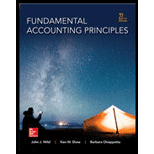
Concept explainers
Concept introduction:
Inventory can be valued at LIFO, FIFO or weighted average method. LIFO means last in first out, in other words the goods which came last can go further first. FIFO means first in first out, in other words the goods which come first can go further first. In both the methods, stock should be valued as last or first stock comes in. while as per weighted average method, remaining stock will be valued at equal rate. In other words whole stock should be totaled and divided by number of weights so that average weight should be found out. This average rate should be multiplied by closing stock.
Requirement 1:
We have to determine the
Requirement 2:
We have to prepare the
Requirement 3:
We have to determine the journal entry for various transactions.
Requirement 4:
We have to determine the ledger accounts.
Requirement 5:
We have to determine the gross profit from sales in july.
Want to see the full answer?
Check out a sample textbook solution
Chapter 20 Solutions
Fundamental Accounting Principles -Hardcover
- Please provide the solution to this general accounting question using proper accounting principles.arrow_forwardAfter the year-end adjustment, what is the net realizable value of accounts receivable?arrow_forwardVantage Components, Inc. determined at the beginning of the year that estimated overhead costs would be $650,000, and the estimated allocation base would be 65,000 direct labor hours. By the end of the year, actual overhead costs totaled $698,000, and actual direct labor hours worked were 68,500. What was the dollar amount of underallocated or overallocated manufacturing overhead?arrow_forward
- Please provide the accurate answer to this general accounting problem using valid techniques.arrow_forwardPlease provide the solution to this general accounting question using proper accounting principles.arrow_forwardWhen using the allowance method, the entry to record estimated uncollectible accounts includes a: (A) Debit to Allowance for Doubtful Accounts (B) Credit to Bad Debt Expense (C) Credit to Allowance for Doubtful Accounts (D) Debit to Accounts Receivable MCQarrow_forward

 AccountingAccountingISBN:9781337272094Author:WARREN, Carl S., Reeve, James M., Duchac, Jonathan E.Publisher:Cengage Learning,
AccountingAccountingISBN:9781337272094Author:WARREN, Carl S., Reeve, James M., Duchac, Jonathan E.Publisher:Cengage Learning, Accounting Information SystemsAccountingISBN:9781337619202Author:Hall, James A.Publisher:Cengage Learning,
Accounting Information SystemsAccountingISBN:9781337619202Author:Hall, James A.Publisher:Cengage Learning, Horngren's Cost Accounting: A Managerial Emphasis...AccountingISBN:9780134475585Author:Srikant M. Datar, Madhav V. RajanPublisher:PEARSON
Horngren's Cost Accounting: A Managerial Emphasis...AccountingISBN:9780134475585Author:Srikant M. Datar, Madhav V. RajanPublisher:PEARSON Intermediate AccountingAccountingISBN:9781259722660Author:J. David Spiceland, Mark W. Nelson, Wayne M ThomasPublisher:McGraw-Hill Education
Intermediate AccountingAccountingISBN:9781259722660Author:J. David Spiceland, Mark W. Nelson, Wayne M ThomasPublisher:McGraw-Hill Education Financial and Managerial AccountingAccountingISBN:9781259726705Author:John J Wild, Ken W. Shaw, Barbara Chiappetta Fundamental Accounting PrinciplesPublisher:McGraw-Hill Education
Financial and Managerial AccountingAccountingISBN:9781259726705Author:John J Wild, Ken W. Shaw, Barbara Chiappetta Fundamental Accounting PrinciplesPublisher:McGraw-Hill Education





